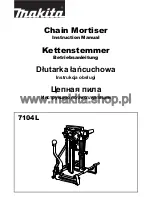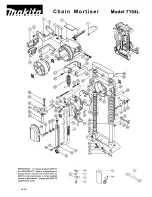
5
intended for. This container should be kept as it will prove
useful for your work.
INSTALLATION
The environmental conditions, temperature, humidity, lighting,
the correct dislocation of your tool and the cleanliness of the
place of work are important conditions for personal safety
and tool performance. These factors should always be kept
under control in order to improve working conditions and
ensure safety.
ELECTRICAL CONNECTION
Before connecting the tool to the mains make sure that it
complies with the standard regulations of the country in
question, and that the voltage and frequency correspond to
the details on the data plate.When using extension leads,
make sure that cable cross-section conforms to the length of
the lead. When using a wind-up extension make sure that is
completely unwound so as to avoid overheating.
ATTENTION! - The switch on this tool is fitted with a locking
device, allowing the tool to be operated for long periods of
time without interruptions. Before inserting the plug into the
socket, check that the switch is in the unlocked position.
When the tool is not to be used for long periods remember to
leave the switch device in the unlocked position.
PLACE OF WORK
The tool that you have purchased is a portable electric power
tool. Only one user should operate this tool, given its shape,
weight and maneuverability. Normal use requires that both
of the operator’s hands are firmly kept on the machine and,
under all circumstances, away from the applied tool.5The tool
is already regulated according to standard parameters by the
constructor when supplied. If necessary oscillation and speed
adjustments can be carried out on the “/E” model.
OSCILLATION REGULATION (fig.1-2)
With this movement, during the working stroke, the blade
is pressed against work piece, during the return stroke the
blade is detached from the material in order to facilitate the
discharging of chips and reduce overheating. The regulation
of oscillatory movements can be carried out whilst the
machine is running: Switching from position “0” to position
“III” is by means of the lever N. In order to obtain maximum
working speed and the best results on any type of material,
the appropriate oscillation should be applied.- For wood and
soft synthetic material, maximum oscillation is required,
therefore the regulator should be set at position “III”.- For steel
and hard materials, the blade should not be forced against
the material, therefore the oscillation should be at minimum,
with the regulator be set at position “0”. - For materials with
intermediate hardness, such as aluminium or hard wood,
positions “I” or “II” should be used, after the appropriate tests
have been carried out. The values supplied are approximate
and can vary according to the thickness, hardness and the
fiber direction of the material and blade condition.
SPEED REGULATION
In order to improve the machine performance, and provide
maximum working efficiency on all types of material, use the
saw model with electronic speed control.
The orange knurled knob H (Fig.1) is mounted on the body of
the machine and is marked with numbers from 1 to 6.Minimum
speed is at position 1 and the speed progressively increases
to max. speed at position 6. The following speeds are advised:
Low speed for cutting glass, ceramics, metal. Average speed
for cutting plastic, pressed or compensated materials. High
speed for cutting hard wood, soft wood and masonite panels.
Carefully choose the ideal speed for the work that has to be
performed by carrying out preliminary tests.
REGULATION OF SUPPORT BASE (fig.3)
Angled cuts of up to 5° can be performed. In order to carry
out this operation proceed as follows:
- Overturn the machine
- Using an Allen wrench, loosen the flathead screw which
holds the base onto the head of the machine.
- Adjust to the desired angle, with the aid of the graduated
scale.
- Re-tighten the flathead screw.
OPERATION AND USE
Felisatti jig saws are particularly sturdy and resistant
machines; extremely versatile and maneuverable, ideal for
all continuous cutting work with wood, aluminum, plastic,
steel, etc.
1.
STARTING
JSF120/750E
Push the key forwards until it locks into position (direction I),
in this position the switch is locked in “ON”.
Attention: to unlock the switch, press the orange key towards
the position “0”.
JSF65/550E, JSF85/600E, JSF100/700E
Press the switch key, to lock it in ON, activate the lock push
button located next to the switch.
Attention
In order to unlock the switch, fully press the switch
key - in this manner the lock push button will trip
automatically.
2. HANDGRIP
JSF120/750E
The grip-shaped machine body allows the tool to be perfectly
guided, the knob handgrip, located on the head, completes
the tool governability.
Attention
During working operations both hands must be kept
firmly on the machine.
JSF65/550E, JSF85/600E, JSF100/700E
These machines are fitted with “flatiron” shaped bodies,
providing perfect grip and excellent balance under all working
conditions, resulting in incomparable maneuverability.
Attention
Given the special shape of the body, these machines can
be operated with only one hand, but for reasons of safety
it is strongly advised to keep both hands on the machine
during use.
HOLLOW WORK PIECES
A hole must be drilled in the material, in order to provide a
starting point for the saw.
Содержание JSF65/550E
Страница 2: ......
Страница 33: ...33 8...
Страница 35: ...35 1 2 N 0 I II III 0 I II 1 1 6 1 6 3 45...
Страница 38: ...38...
Страница 39: ...39...






































